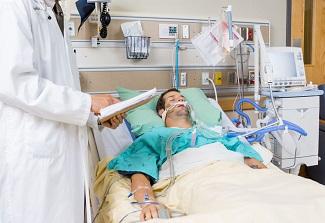Tissue Trauma to the Scrotum: An Avoidable Offense
July 1, 2019
Have you noticed the tissue trauma that occurs to the posterior aspect of the scrotum? It appears like road rash, partial tissue loss, and denudation. Many times it is weepy, and it appears quite painful to the patient.
My observation of this phenomenon has been in the intensive care unit (ICU). It occurs after the male patient has been given adequate amounts of hydration to treat their condition of sepsis or hypotension, etc. Generalized edema or third spacing is occurring, and it does not spare the scrotal sac. This engorgement of the scrotal tissue debilitates the epidermis. Moisture from buttocks, perineum, and groin is the number one culprit, creating tissue maceration, leading to moisture-associated skin damage.
The staff, in an attempt to alleviate pressure, will devise ways to elevate the scrotum with rolled towels, pillows, and other ICU nurse creative and inventive ways.
I have observed that the trauma to the posterior aspect of the scrotum occurs when such rolls are removed by pulling them off instead of lifting the scrotum first and then gently removing the support used for elevation.
Preventing Tissue Trauma to the Posterior Aspect of the Scrotum
Several steps have been formulated for staff on and practice in preventing tissue trauma to the scrotum:
- Before repositioning the patient with or without scrotal edema, ensure that the scrotum is pulled off from its sequestered state between the legs and is gently moved to the front, or top of the thighs. Now proceed to pull patient up in the bed.
- Gentle cleansing with a pH-balanced hydrating foam is advised, as well as the use of a soft disposable cloth, and not a terrycloth washcloth. Gently pat dry, and follow with a gentle but thorough application of a barrier ointment or gel.
- Utilization of a silver-impregnated cloth to wick away moisture is advisable, although it should be used with caution if a barrier paste has been applied. (The ointment will interfere with the wicking properties of the cloth.)
- The use of a small gel positioner that can be conformed to "hammock" the scrotum is placed below the scrotum and between the thighs to provide this needed elevation.
- And, last but not least, always remember to bring “the jewels in the trunk to the front.”
Conclusion
Although this is hardly rocket science, it is a skin care concern, and tissue trauma that can be prevented and avoided is for all wound, ostomy, and continence nurses an event that is not ever to be taken for granted.
About the Author
Fabiola Jimenez is a Wound Ostomy Continence Nurse and Adult Clinical Nurse Specialist at Detroit Medical Center Huron Valley Sinai Hospital. She has been a nurse since 1988, when she entered the field after graduating from the University of Oklahoma. Throughout her accomplished career, her work has demonstrated a dedication to caring for patients and a lifelong commitment to educating herself and others.
The views and opinions expressed in this content are solely those of the contributor, and do not represent the views of WoundSource, HMP Global, its affiliates, or subsidiary companies.











